Guide to caring for grapes in August and advice from experienced winegrowers
Beginner gardeners assume that after harvesting the vineyard does not need attention, and the plants need to be cared for only in the spring, after the snow has melted. This assumption is incorrect: even after fruiting has passed, the crop requires watering, fertilizing and pruning. The right approach guarantees not only a rich harvest next year, but also a problem-free wintering of the bushes.
What care does grapes require in August?
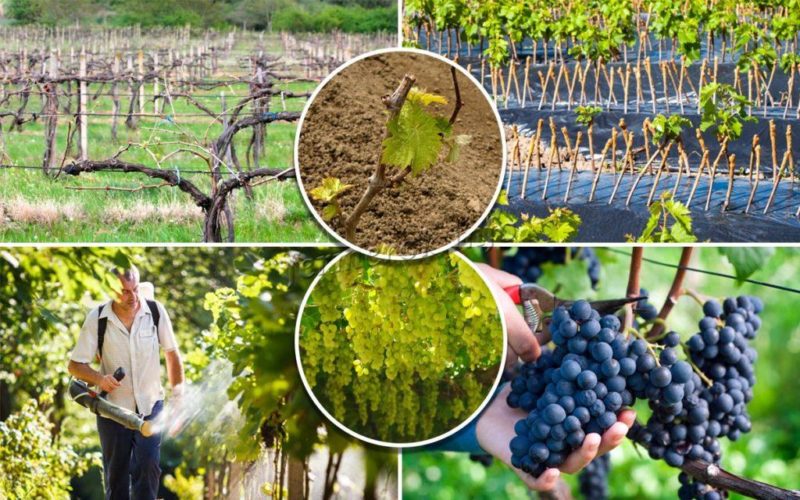
In August, most grape varieties enter the fruiting period. In order for the clusters to grow large and sweet, gardeners engage in agrotechnical measures: trimmed and form plants feed and water, loosen and mulch. Be sure to carry out treatment against diseases and insect pests in August so that they do not eat ripe and juicy berries. The procedures determine how the bush will survive autumn and winter, and what the fruit set will be like next year.
At the beginning of the month, stepchildren and green shoots are cut out. Excess vegetation interferes with the development of bunches and takes away nutrients, causing the fruits to grow small and insipid. It is also recommended to carry out formative pruning: it gives the plant a well-groomed appearance and protects it from the appearance of insect pests.
In the second half of August, the grapes ripen; traces of rot or other diseases may appear on the fruits. In this case plants are treated folk remedies, since the use of chemicals is dangerous to health.A week after harvest, the vineyards are sprayed with a solution of boric acid. The procedure strengthens the plant’s immunity and increases its frost resistance. Additionally, they clean the ground from fallen leaves and fruits to prepare the vineyard for winter.
What to do in the vineyard in August
Work on the vineyard is carried out throughout the year. Let's look at what it is grape care in August and how to perform the procedures correctly.
Watering
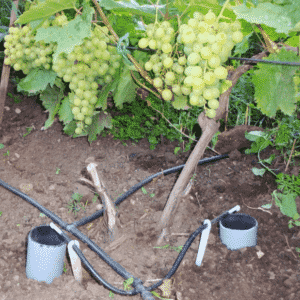
Frequency and abundance watering depend on weather conditions. In the southern regions, summers are warm and long, so they moisten the soil until the end of the month, gradually reducing the amount of water.
On average, one adult bush uses about 12 liters of water, at the end of August - about 7 liters. In the northern regions, watering stops by mid-August.
It is not recommended to irrigate bushes on which ripe and large berries hang: excessive moisture provokes cracking and rotting of the fruits.
Moisten the plant at the root; water should not get on the leaves, shoots and berries. It is recommended to carry out the procedure in the morning or evening. The water is first heated in the sun. Stop moisturizing 3 weeks before harvest; if August is dry - 2 weeks in advance. To ensure that water penetrates deeper to the roots, the soil is first loosened to a depth of 10 cm.
Top dressing
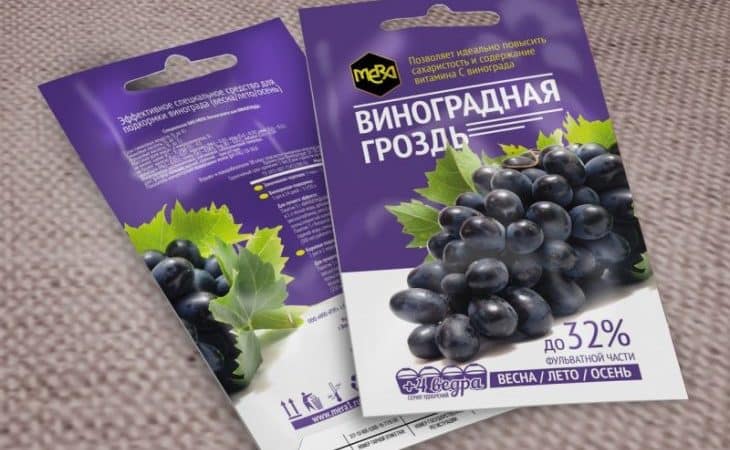
August is not the best time to apply complex fertilizing. An excess of mineral fertilizers leads to the fact that the green mass grows, but the fruits remain small, their ripening slows down. Summer residents are advised to pay attention to folk remedies for root and foliar fertilizers. They are harmless to humans and the environment and easy to prepare.Such compositions strengthen the plant’s immunity, stimulate fruit ripening and protect against diseases.
One effective remedy is yeast infusion. Mix 200 g of yeast in 1 liter of warm water, mix and leave for 6 hours. Dilute the solution with clean water in a 1:1 ratio and spray the vineyard. 1 bush uses 1 liter of product. An ash solution is prepared using the same principle: instead of yeast, 130 g of dry ash is added to the water. It nourishes the soil and improves the quality of the fruit.
Treatment

Treatment against diseases and pests is carried out throughout the summer.. Due to hot weather and high humidity, grapes become sick with mildew - downy mildew. The drugs “Quadris” and “Ridomil” help get rid of fungal disease. They are used provided that there is 1 month left before harvest. If the grapes are sick with scab or oidium, they are sprayed with a solution of boric acid: 100 g of the substance is diluted in 10 liters of warm water. The treatment is carried out in dry and warm weather, after removing infected leaves and fruits from the bush.
Attention! A common crop pest in August is the grape budworm. Caterpillars eat leaves, shoots, and fruits. They overwinter in soil and plant debris; in summer, butterflies multiply rapidly. They get rid of the pest using the drugs “Arrivo”, “Fufanon” or “Ekamet”.
If mole crickets, aphids or spider mites have settled on the plant, it is recommended to use a solution of copper sulfate. 100 g of powder requires 10 liters of water. Dilute the solution in a plastic or glass container and store it for no more than 10 hours after treatment. In addition to insects, the product quickly copes with various types of rot. The vineyard is not filled with solution, but sprayed.
Coinage

Minting is carried out when the grapes begin to ripen, the fruits swell and change color. It is recommended to do this in cloudy weather, without rain or wind. Summer residents remove the tops of the vines by 20 cm. When the berries ripen, the vines stop developing, and the young shoots ripen. The green vine turns to light brown.
Thanks to embossing, the bunches are illuminated from all sides, which affects the improvement of the marketability and taste of the crop. The procedure increases the plants' resistance to frost and disease. In areas with a humid and cool climate (for example, in the Urals), caulking is required for better ventilation of the bushes. It accelerates the ripening of large fruits.
Inexperienced gardeners believe that chasing and pinching are the same thing. This is not so: pinching is carried out before or at the beginning of flowering, and chasing - before fruiting. During pinching, only the tops are removed, and during chasing, a significant part of the shoot is removed.
Trimming

Pruning is carried out in the second half of August. For the procedure, use sharp pruning shears or scissors; they are disinfected with a solution of potassium permanganate. All bushes over 2 years old require pruning. In August, different procedures are relevant: formative or sanitary.
Formative pruning gives the bush its shape. To do this, all chaotically growing shoots and branches that are tangled together are cut out. As a result, the vines are ventilated, reducing the risk of rot or fungal diseases.
During sanitary pruning, all diseased, dry and damaged shoots are removed. Next year, new fruit-bearing vines will grow in their place. It is important that all cuts and wounds are only on the inside of the shoots: this way they heal faster. After the procedure, the damage is treated with garden varnish.The cut is made obliquely, sloping towards the eye.
Mulching
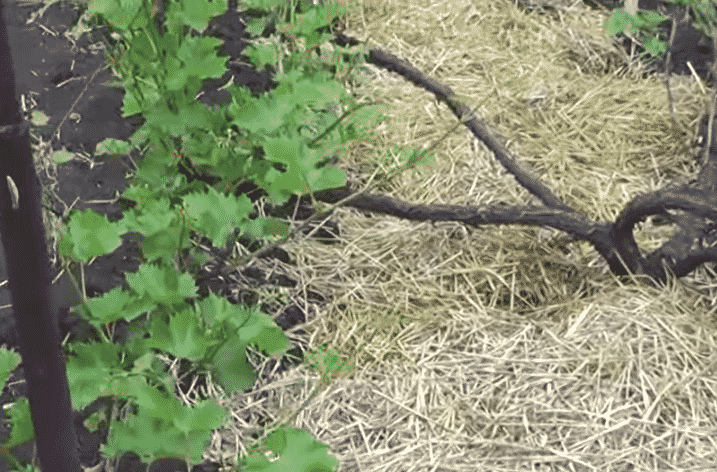
Mulch prevents the emergence of weeds, improves the development and nutrition of the root system. In August it is applied for the last time, having previously loosened the soil and cleared it of debris. It is recommended to use organic mulch: dry grass, bark, wood chips, ash, hay. Layer thickness is about 8 cm.
Mulch retains water and protects roots from overheating in the southern regions of the country. If the soil is dry and sandy, mulch the soil with leaves. On clay soils, sawdust or river sand is used.
Loosening
Loosening is especially important in hot and dry summers. The soil in such conditions instantly absorbs moisture, the roots quickly absorb it. To ensure that water stays in the ground longer, once a week the soil is loosened to a depth of 7–10 cm with a garden hoe. This procedure opens up oxygen access to the roots, which protects the grapes from diseases. It is not recommended to loosen the soil deeper than 10 cm: there is a risk of damaging the roots.
Post-harvest care

After harvesting, the vineyard is inspected for diseases and pests. If there are signs of damage, the plant is sprayed with a solution of copper sulfate or Bordeaux mixture. Diseased shoots and leaves are removed and burned outside the garden area. If there are no symptoms of infection, the vineyard is treated with prophylactic agents: infusion of nettle or ash, the drug “Strobi”. The procedure protects plants from insects and diseases in autumn and winter.
Attention! Preparing the vineyard for autumn involves removing all fallen leaves from the area, watering and feeding the plants, pruning and treating them against diseases.The next time they return to the vineyard only before the cold weather - they cover it for the winter.
After preventive treatment, the last fertilizing is carried out - potassium salt or potassium sulfate is added. Fertilizers nourish the soil and increase the plant’s resistance to frost and wind. After fertilizing, the grapes are mulched.
Nuances for different regions
In the Moscow region the majority varieties ripens by the end of August, so it is recommended to cultivate the vineyard before the 10th of the month. In the Urals and Siberia, the crop is harvested later, so spraying is carried out in early August. For the treatment to have an effect, it is important to do it in dry weather.
When watering, summer residents are urged to pay attention to climatic conditions. In the Moscow region and southern regions, vineyards are watered abundantly and often, in the northern regions - depending on how often it rains. The soil should not be constantly wet: this entails the development of fungal diseases.
Advice from experienced winegrowers
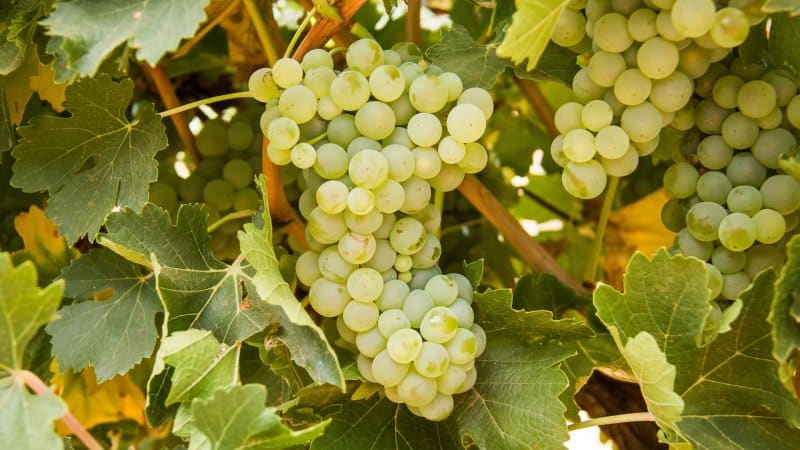
Experienced winegrowers know how to grow a good harvest and properly care for the bushes all year round.
They recommend:
- collect ripe grapes in a timely manner, preventing the fruits from falling to the ground;
- regularly inspect the vineyard for pests and other damage;
- if the bush is affected by the disease by more than 80%, remove it from the site and burn it;
- do not remove shoots that have reached 15 cm in length;
- pinching at the beginning of summer, not at the end;
- thin out leaves along with pruning;
- do not use nitrogen-containing fertilizers and organic matter in August.
Conclusion
Caring for grapes at the end of summer includes moisturizing and fertilizing. Water the grapes in the morning or evening, the amount depends on weather conditions.They are fed with potassium supplements and treated with a solution of Bordeaux mixture to strengthen the immune system.
Pay attention to embossing and trimming: activities stimulate the ripening of bunches and improve the air permeability of bushes. Proper and timely care ensures that heat-loving shrubs will not freeze in autumn and winter and will retain their ability to bear fruit next year.